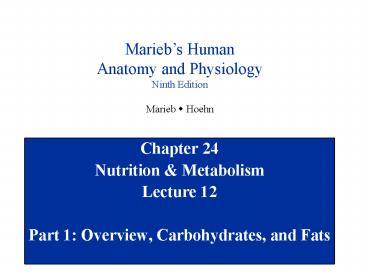Nutrition - PowerPoint PPT Presentation
Title:
Nutrition
Description:
Title: NVCC Bio 212 Subject: Nutrition and Metabolism Author: Greg Erianne Last modified by: Gregs Desktop Created Date: 1/14/2003 11:24:43 PM Document presentation ... – PowerPoint PPT presentation
Number of Views:99
Avg rating:3.0/5.0
Title: Nutrition
1
Mariebs Human Anatomy and Physiology Ninth
Edition Marieb w Hoehn
- Chapter 24
- Nutrition Metabolism
- Lecture 12
- Part 1 Overview, Carbohydrates, and Fats
2
Nutrients
Nutrients chemical substances supplied by the
environment required for survival (used for
growth, repair, or maintenance of the body)
- Macronutrients
- carbohydrates
- proteins
- fats
- Micronutrients
- vitamins
- minerals
- Essential Nutrients
- human cells cannot synthesize
- include certain fatty acids, amino acids,
vitamins
3
Overview of General Metabolic Pathways
Overall goal of catabolism generate a pool of 2-
or 3-carbon molecules and ATP
?Lipo-genesis
?Glycogenesis
Glycogenolysis ?
Lipolysis ?
Pyruvate is used to synthesize amino acids and
Acetyl CoA Pyruvate can also be used to
synthesize glucose via gluconeogenesis.
Figure from Martini, Anatomy Physiology,
Prentice Hall, 2001
4
Carbohydrates
- Sources
- sugars (simple)
- starches (complex) - usually from plant sources
- glycogen (complex) in meats
- cellulose (complex) is indigestible fiber
- Excesses lead to
- obesity
- dental caries
- nutritional deficits
- Deficiencies lead to
- metabolic acidosis
- weight loss
Recommended (Dietary) Daily Allowance (RDA) is
125-175g
5
Utilization of Carbohydrates
Glucose is the bodys CHO energy source
Figure from Holes Human AP, 12th edition, 2010
6
Lipids
- Sources
- meats
- eggs
- milk
- lard
- plant oils
- Excesses lead to
- obesity
- increased serum cholesterol
- increased risk of heart disease
- Deficiencies lead to
- weight loss
- skin lesions
- hormonal imbalances
RDA is 80-100g (? 30 of calories) (? 10
saturated fat)
Fats generally take the longest to digest. Why?
7
Utilization of Lipids
Figure from Saladin, Anatomy Physiology,
McGraw Hill, 2007
Via what structures is fat absorbed into the
circulation from the digestive tract?
Know these terms (see table of these terms later
in this lecture)
Oxaloacetic acid
8
Beta-Oxidation of Fatty Acids
Mitochondrion
Long chain fatty acids (FA) require carnitine for
transport into mitochondria FA are broken down
in a step-wise manner, 2 carbons at a time in
beta-oxidation Oxidation of FA yields about
1.5-2.0 times the energy from a comparable amount
of glucose
9
Energy Values of Food
Calorie (kilocalorie, big calorie) amount of
heat needed to raise the temperature of 1 kg of
water by 10 C
Carbohydrates 4.1 Calories per gram
Diet is 2000 Calories. What is the maximum
number of grams of fat that should be taken in
daily?
Proteins 4.1 Calories per gram
How many grams of fat are there in a Whopper with
cheese and a small order of french fries?
Lipids 9.5 Calories per gram
Know this - you can round these off to the 4, 4,
and 9)
10
So, whats going on here?
Why do the calories for 12 oz. of this beer seem
to be more than what you would suppose based on
the CHO and protein content?
14g CHO x 4 cal/g 56 cal 1g protein x 4
cal/g 4 cal Total
60 cal
Alcohol! About 7 cal/g
11
Lipoprotein Traffic
Figure From Martini, Anatomy Physiology,
Prentice Hall, 2001
TG-rich
Cholesterol-rich
Cholesterol can be manufactured from Acetyl-CoA
Note the role of HDLs as scavengers of
tissue/blood cholesterol.
12
Summary of Lipoproteins
Designation Origin Action
Chylomicron GI tract Transports dietary fats (mainly triglycerides) to liver for processing
Very Low Density Lipoprotein (VLDL) Liver Transports triglycerides from liver to adipose cells
Low Density Lipoprotein (LDL) Liver Transports cholesterol from liver to cells in body
High Density Lipoprotein (HDL) Liver Removes excess cholesterol from cells and transports to liver
Know this chart
13
Utilization of Lipids
The liver uses fatty acids to synthesize a
variety of lipids
Chem Figures From http//en.wikipedia.org/wiki/
Linoleic (? 6)
Linolenic acid, EPA, and DHA (? 3)
Figure From Holes Human AP, McGraw Hill, 2012
14
Review
- Metabolism and fate of macronutrients
- Carbohydrate
- Broken down into monosaccharides
- Metabolism, glycogen, fat, pentose sugars
- Lipids
- Saturated vs. unsaturated fats
- Broken down into glycerol and fatty acids
- Used for energy (or storage of energy)
- Proteins
- Complete vs. incomplete proteins
- Broken down into amino acids
- Structural components or energy































